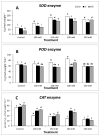Impact of Silica Ions and Nano Silica on Growth and Productivity of Pea Plants under Salinity Stress
- PMID: 35214827
- PMCID: PMC8876481
- DOI: 10.3390/plants11040494
Impact of Silica Ions and Nano Silica on Growth and Productivity of Pea Plants under Salinity Stress
Abstract
The present study was conducted to evaluate the effects of silicon (Si) and nano-silicon (NSi) on growth, yield, ions content, and antioxidant defense systems, including transcript levels of enzyme-encoding genes in Pisum sativum plants grown under salinity stress. Both Si and NSi were applied at the 3 mM level and NaCl was applied at 4 concentrations (100, 150, 200 and 250 mM). Vegetative growth, including plant height, leaf area, fresh and dry weights, and yield attributes were determined. Gene expression of antioxidant enzymes was analyzed, and their activities were determined. The results showed that salinity had deleterious effects on plant growth and yield. Salt-stressed plant leaves exhibited a greater activity of superoxide dismutase (SOD), peroxidase (POD), but a lower activity of catalase (CAT) when compared to the control. Na+ ions accumulated in roots and shoots of salinized plants. The application of Si and NSi significantly enhanced vegetative growth and relative water content (RWC), and caused significant increases in plant height, fresh and dry weight, total yield, and antioxidant defense systems. Si and NSi enhanced K+ content in roots and shoots under salinity treatment and decreased Na+ content in the studied tissues. It was concluded that the application of NSi was beneficial in improving the salt tolerance of Pisum sativum plants more than Si alone.
Keywords: Pisum sativum; antioxidants; gene expression; growth; nano-silicon; silicon.
Conflict of interest statement
The authors declare no conflict of interest.
Figures



References
-
- Taha R.S., Seleiman M.F., Alhammad B.A., Alkahtani J., Alwahibi M.S., Mahdi A.H.A. Activated Yeast Extract Enhances Growth, Anatomical Structure, and Productivity of Lupinus termis L. Plants under Actual Salinity Conditions. Agronomy. 2021;11:74
-
- Zheng L., Shannon M.C., Lesch S.M. Timing of salinity stress affecting rice growth and yield components. Agric. Water Manag. 2001;48:191–206. doi: 10.1016/S0378-3774(00)00146-3. - DOI
-
- Zayed B.A., Okasha A.M., Rashwan E. Impact of different rates of phosphoric acid foliar applicationing on rice growth and yield traits under normal and saline soils conditions. J. Agric. Life Sci. 2019;2:56–66.
-
- Tulbek M.C., Lam R.S.H., Wang Y.C., Asavajaru P., Lam A. Pea: A sustainable vegetable protein crop. In: Nadathur S.R., Wanasundara J.P.D., Scanlin L., editors. Sustainable Protein Sources. Academic Press; San Diego, CA, USA: 2016. pp. 145–164.
LinkOut - more resources
Full Text Sources
Miscellaneous

